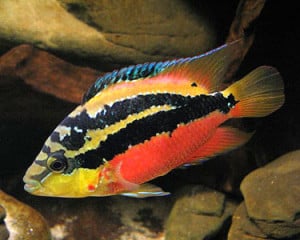
Common Name: Salvini, Tricolor Cichlid
Scientific Name: Cichlasoma Salvini
Average Adult Fish Size: 15 cm / 6 inches
Place of Origin: Atlantic side of Central America where it can be found from Southern Mexico down through Guatemala and Belize.
Typical Tank Setup: Decorate the aquarium using hardy plants, rocks and roots. The Salvini Cichlid sometimes likes to dig so it is recommendable to place rocks around the base of the plants to prevent them from uprooting them. It is also recommended to secure all rock formations and placing rocks directly on the bottom of the tank to help prevent digging related accidents. Divide the bottom of the tank into sections by placing rocks and roots on the bottom of the tank. This makes it easier for the fish to create borders for their territories and allows for more territories and less aggression.
Recommended Minimum Aquarium Capacity: 30 gallon / 120 litre for one to 40 gallon / 160 litre for a pair
Compatibility: Community Cichlid aquarium with other semi-aggressive Cichlids.
Temperature: 22 – 27 Deg C / 72 – 81 Deg F
Water Chemistry: pH 7.0 – 8.0
Feeding: Flake, pellet, and frozen foods. A varied diet is best.
Sexing: Males have longer and more pointed fins and are usually slightly larger and more colorful than females. The only accurate way to sex juveniles though is to vent them.
Breeding: Supply a cave, slate, and/or clay flower pot. They are substrate breeders and are relatively easy to breed. The eggs are deposited on a flat surface and guarded by both parents. They usually hatch in about 5 days and are free swimming a few days later. Salvini Cichlid fry can be fed newly hatched brine shrimp or micro worms as soon as they are free swimming.
Additional Information: The Salvini cichlid is easy to care for. They produce a lot of waste for their size so regular and large water changes are a necessity. Change at least 25 % of the water 1 or 2 times a week. Exactly how much and how often you need to change water depends on the size of the fish and the size of the aquarium. Monitor nitrates to find out how often you need to change water.


Related Posts
Croaking Gourami – Trichopsis vittatus
Benthochromis Tricoti
Large-eyed Mouthbrooder – Callochromis Macrops